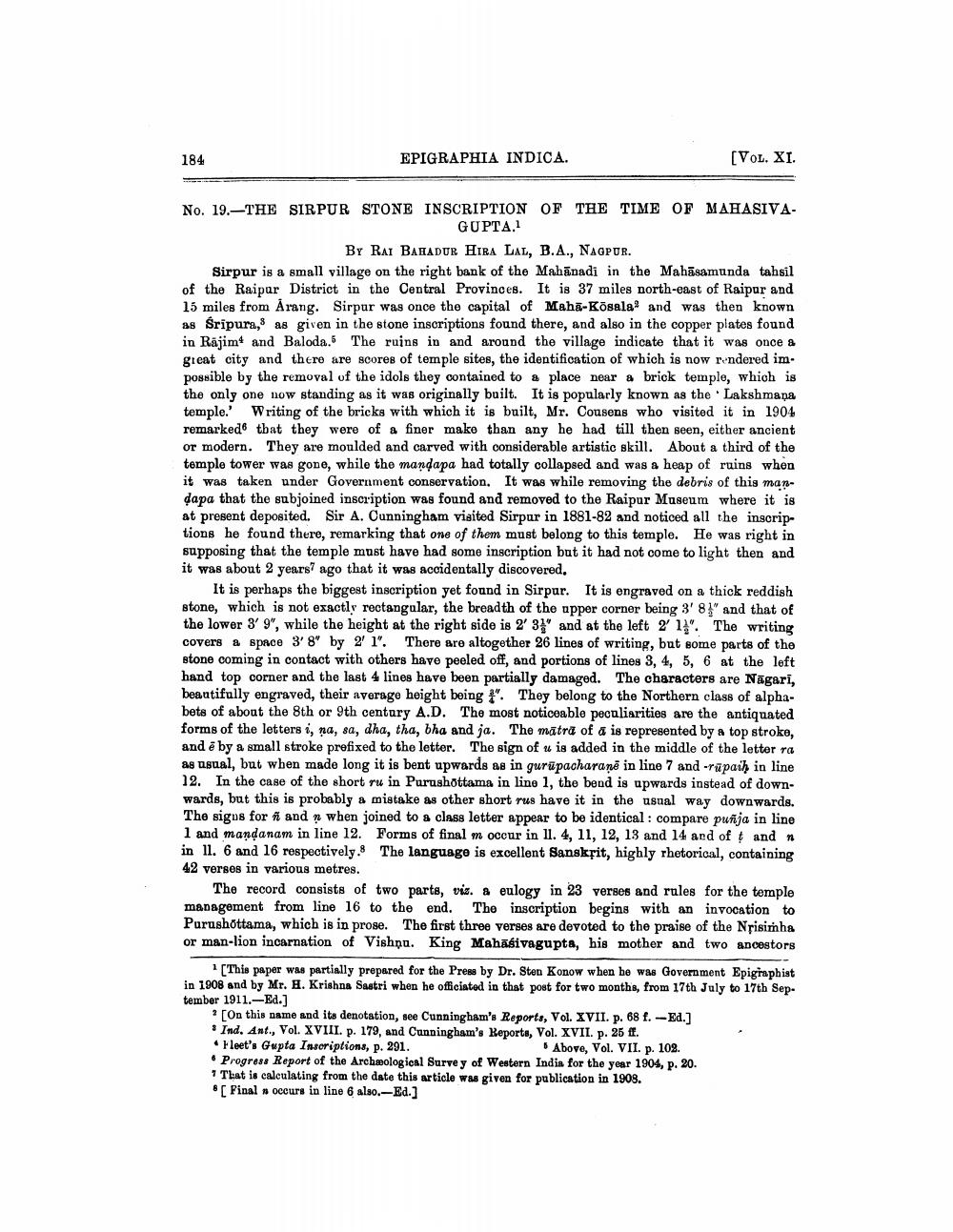________________
184
EPIGRAPHIA INDICA.
[VOL. XI.
No. 19. THE SIRPUR STONE INSCRIPTION OF THE TIME OF MAHASIVAGUPTA.1
BY RAI BAHADUR HIRA LAL, B.A., NAGPUR.
Sirpur is a small village on the right bank of the Mahanadi in the Mahasamunda tahsil of the Raipur District in the Central Provinces. It is 37 miles north-east of Raipur and 15 miles from Årang. Sirpur was once the capital of Maha-Kōsala and was then known as Sripura, as given in the stone inscriptions found there, and also in the copper plates found in Rajim and Baloda. The ruins in and around the village indicate that it was once a great city and there are scores of temple sites, the identification of which is now rendered impossible by the removal of the idols they contained to a place near a brick temple, which is the only one now standing as it was originally built. It is popularly known as the Lakshmana temple.' Writing of the bricks with which it is built, Mr. Cousens who visited it in 1904 remarked that they were of a finer make than any he had till then seen, either ancient or modern. They are moulded and carved with considerable artistic skill. About a third of the temple tower was gone, while the mandapa had totally collapsed and was a heap of ruins when it was taken under Government conservation. It was while removing the debris of this mandapa that the subjoined inscription was found and removed to the Raipur Museum where it is at present deposited. Sir A. Cunningham visited Sirpur in 1881-82 and noticed all the inscriptions he found there, remarking that one of them must belong to this temple. He was right in supposing that the temple must have had some inscription but it had not come to light then and it was about 2 years ago that it was accidentally discovered.
It is perhaps the biggest inscription yet found in Sirpur. It is engraved on a thick reddish stone, which is not exactly rectangular, the breadth of the upper corner being 3' 8" and that of the lower 3' 9", while the height at the right side is 2' 33" and at the left 2' 1". The writing covers a space 3' 8" by 2' 1". There are altogether 26 lines of writing, but some parts of the stone coming in contact with others have peeled off, and portions of lines 3, 4, 5, 6 at the left hand top corner and the last 4 lines have been partially damaged. The characters are Nagari, beautifully engraved, their average height being ". They belong to the Northern class of alphabets of about the 8th or 9th century A.D. The most noticeable peculiarities are the antiquated forms of the letters i, na, sa, dha, tha, bha and ja. The matra of a is represented by a top stroke, and é by a small stroke prefixed to the letter. The sign of u is added in the middle of the letter ra as usual, but when made long it is bent upwards as in gurupacharane in line 7 and -rupaih in line 12. In the case of the short ru in Purushottama in line 1, the bend is upwards instead of downwards, but this is probably a mistake as other short rus have it in the usual way downwards. The signs for and a when joined to a class letter appear to be identical: compare puñja in line 1 and mandanam in line 12. Forms of final m occur in 11. 4, 11, 12, 13 and 14 and of and n in 11. 6 and 16 respectively. The language is excellent Sanskrit, highly rhetorical, containing 42 verses in various metres.
The record consists of two parts, viz. a eulogy in 23 verses and rules for the temple management from line 16 to the end. The inscription begins with an invocation to Purushottama, which is in prose. The first three verses are devoted to the praise of the Nrisimha or man-lion incarnation of Vishnu. King Mahasivagupta, his mother and two ancestors
[This paper was partially prepared for the Press by Dr. Sten Konow when he was Government Epigraphist in 1908 and by Mr. H. Krishna Sastri when he officiated in that post for two months, from 17th July to 17th September 1911.-Ed.]
2 [On this name and its denotation, see Cunningham's Reports, Vol. XVII. p. 68 f. -Ed.] Ind. Ant., Vol. XVIII. p. 179, and Cunningham's Reports, Vol. XVII. p. 25 ff. Fleet's Gupta Inscriptions, p. 291. Above, Vol. VII. p. 102. Progress Report of the Archeological Survey of Western India for the year 1904, p. 20. 7 That is calculating from the date this article was given for publication in 1908. [ Final n occurs in line 6 also.-Ed.]




